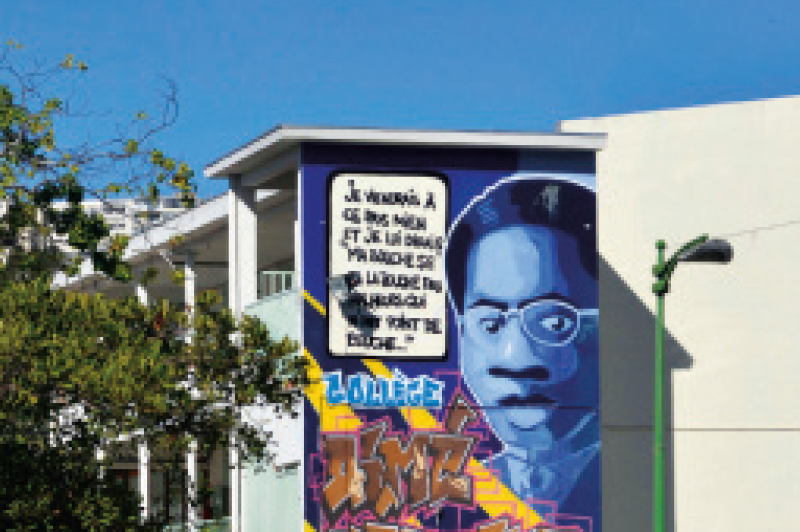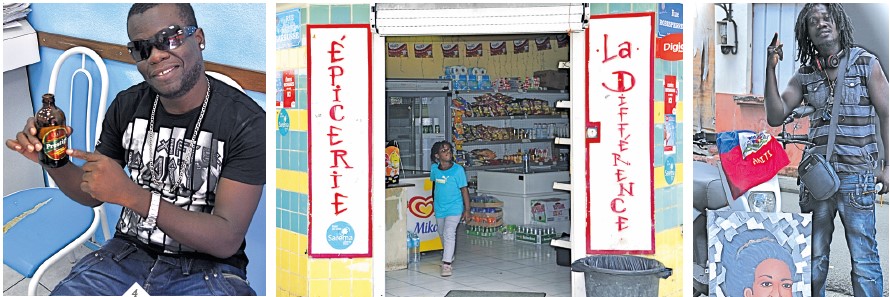
The 30 hectares of Terres-Sainvilles house the largest multi-cultural population in Martinique. Over 15 nationalities live side-by-side, which is no small feat, right in the heart of Fort-de-France. Author Georges Mauvois described it as the contemporary expression of Creole spirit; the foundation of Martinican society as a major multi-ethnic and cultural melting pot.
On June 23, 1920, over 102 years ago, Victor Sévère, who was the mayor of Fort-de-France, bought Faubourg Thébaudière, which was still called the Trénelle or Terres-Sainville. To really understand “TSV,” it is necessary to understand Foyal (editor’s note: contraction of “Fort-Royal,” the former name of Fort-de-France).
THE DREAM OF AN INDUSTRIAL CITY ~ 1835: an earthquake wiped out the capital city. It was decided to rebuild in wood for increased lightness. In 1890, the city was once again destroyed by a fire that started in the Cour Sully in Rue Blénac at the home of a certain Adeline Hercule. From that time on, there has been a “X” on the front of the houses to indicate their load-bearing beams. But it was necessary to rebuild once again after the island was ravaged by a hurricane on August 18, 1891: 400 deaths in Foyal.
What else could possibly happen? On May 8, 1902 the Montagne Pelée volcano exploded: Foyal became the only refuge for those impacted, those immigrating from other parts of the island. This situation only hastened the realization of an old project to create a new Foyal municipality: the neighborhood of Terres–Sainvilles was bought by the city, cleaned up, organized. The mayor, Victor Sévère, created an “industrial city.” He wrote that it was “his ultimate dream, that which sustained him through all the vicissitudes of his political career.”
In fact, it is clear that Foyal got embroiled in the game of real-estate speculation where investors played to their heart’s content. Did prices get too excessive? On January 16, 1904, the Faubourg Thébaudière corporation bought the land for the price of 100,000 francs… Sixteen years later, when the deal was concluded with the mayor of Foyal, prices had gone up by 850%, and the same land was sold for 850,000 francs.
TERRES-SAINVILLE AT THE BEGINNING OF THE LAST CENTURY ~ It is generally understood that the city bought the site from the heirs of Baron Sainville. In fact, it is a little more complicated than that. At the beginning of the last century, the 30-hectare polygon-shaped piece of land—bordered on the east by the Chemin le Pavé, on the north by the Canal de la Trénelle, and on the west by the colonial route and the military hospital, currently the Parc Aimé Césaire, (121`ex-Parc Floral)— belonged to the Lacalle heirs, who had acquired it from Jacques Sainson Sainville.
This Jacques Sainville was a remarkable man. In 1848, with his brother, he freed the slaves found in Fort-de-France and in Le François, and created a share-cropping system. Even better, he invented a payment system for sugarcane based on the level of sugar content. This is the system still used at the Galion sugar refinery. One could talk about the Sainville brothers for days. Like certain remarkable “békés” (editor’s note: term used for the original colonials or their descendants) of that epoque.
Fast forward to 1904. The Lacalle heirs went bankrupt, allowing the Faubourg Thébaudière company, run by Mary de Berry, to be bought “at a court-imposed auction.” What a business! We had a company composed of 1,120 stockholders, including 120 residents of Martinique, whose goal was to profit from the misery of others. There is no other way to describe it, as there were 6,000 souls crammed into little houses that rented for 30 to 60 francs per month. Those were the days when the name “Quartier of Les Misérables” was born. That’s when Joseph Lagrosillière came along.

THE LEGACY OF JOSEPH LAGROSILLIÈRE ~ We often forget that this Samaritan of Morne-des-Esses served for quite some time as a municipal council member from Foyal and was attached to Terres-Sainville. Without going into greater detail, let’s remember that on October 15, 1908, he expressed his wish that the administration authorize the city to make a loan of 1.5 million francs to clean up the neighborhood. His wish was granted. In addition, he was the first to insist that the streets of Foyal would be named after prominent local individuals.
Finally, on November 6, 1908, thanks to Joseph Lagrosillière, still a municipal council member, it was decided to celebrate the abolition of slavery in Foyal. The date selected was April 27, the day the decree was issued.
On the same subject, it is interesting to note that in 1945 Gabriel Henry, secretary of the Communist Party federation and a municipal council member, had the street where the party headquarters was located baptized as “Rue of May 23, 1848,” a national day in homage to the victims of slavery. And if you follow the street to the very end, you arrive at the “Square of May 22,” inaugurated in 1971 to mark the abolition of slavery in Martinique. These are not simple coincidences: Terres-Sainville reflects the history of Martinique and its Creole culture.

A MULTI-CULTURAL NEIGHBORHOOD ~ Since it was officially established, the neighborhood of Terres-Sainville could not be compared to anyplace else in Martinique. Victor Sévère wanted to create an industrial city: the people made it into a bubbling cauldron of multi-culturalism. It is here that modern Creole was born, the language that unified various dialects from the north, south, east, and west of Martinique. This is also where the culture of Creole music would explode.
If the beguine was born in Saint-Pierre, it is in Terres-Sainville that it developed and became popular, in the casinos, in contact with orchestras from around the Caribbean, in this astonishing melting-pot. We often forget that it was here, and not elsewhere, that the Caribbean spirit matured between the two world wars. This amalgam gave us our artists.
You may ask yourself why did the likes of Marcel Misaine, Loulou Boislaville, Marius Lancry, Jacky Alfa, and hundreds of others come here? Because it represents a true mix of international cultures.
Auteur : Éric Hersilie-Héloïse

